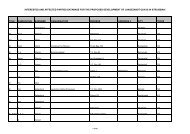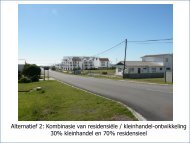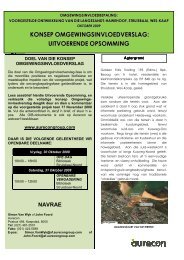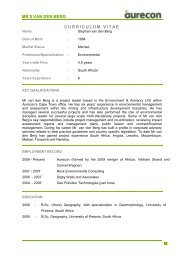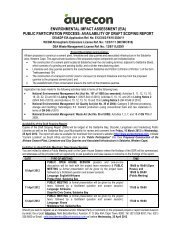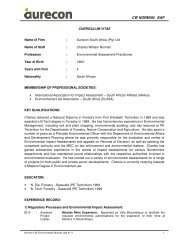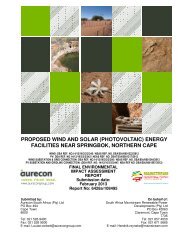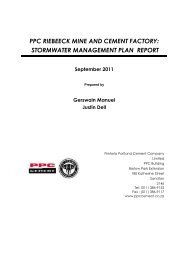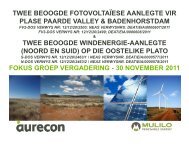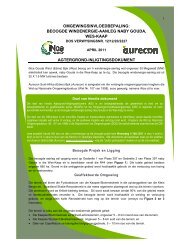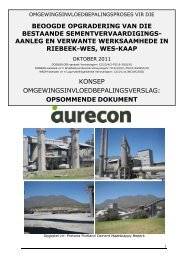Eng~Saldanha Wind Farm BID Eng_Final 02022011.pdf - Aurecon ...
Eng~Saldanha Wind Farm BID Eng_Final 02022011.pdf - Aurecon ...
Eng~Saldanha Wind Farm BID Eng_Final 02022011.pdf - Aurecon ...
You also want an ePaper? Increase the reach of your titles
YUMPU automatically turns print PDFs into web optimized ePapers that Google loves.
ENVIRONMENTAL IMPACT ASSESSMENT PROCESS:<br />
PROPOSED WIND ENERGY FACILITY ON THE FARMS SCHUITJES<br />
KLIP, HONING KLIP, ZANDFONTEIN, KLIPRUG AND HOLVLEI NEAR<br />
VREDENBURG, SALDANHA BAY MUNICIPAL AREA, WESTERN CAPE<br />
DEA REF. NO. 12/12/20/2119<br />
FEBRUARY 2011<br />
BACKGROUND INFORMATION DOCUMENT<br />
IDP Power (Pty) Ltd (IDP Power) proposes to construct a wind energy facility to generate approximately<br />
438 Megawatts (MW) of renewable energy on five farms, near Vredenburg in the Saldanha Bay Municipal<br />
Area in the Western Cape (Figure 1 indicates the general location in which the proposed project is<br />
located.). <strong>Aurecon</strong> South Africa (Pty) Ltd (<strong>Aurecon</strong>) has been appointed to undertake the requisite<br />
environmental process as required in terms of the National Environmental Management Act (No. 107 of<br />
1998), as amended, on behalf of IDP Power.<br />
Purpose of this document<br />
The purpose of this Background Information Document (<strong>BID</strong>) is to provide stakeholders with the opportunity to register as<br />
interested and affected parties (I&APs) in the Environmental Impact Assessment (EIA) process and to obtain their initial<br />
comments on the proposed wind energy facility near Vredenburg, Western Cape.<br />
The purpose of the EIA process is to identify and evaluate feasible alternatives and potential impacts, and to identify potential<br />
measures to avoid or reduce negative impacts and enhance positive impacts. The EIA decision-making authority is the<br />
Department of Environmental Affairs (DEA) in accordance with the National Environmental Management Act (No. 107 of 1998).<br />
Please review this <strong>BID</strong> and submit your comments on the proposed project by Tuesday, 8 March 2011. To comment, please<br />
write a letter, call or e-mail the Public Participation office. All EIA documents will be available on the <strong>Aurecon</strong> (Pty) Ltd (<strong>Aurecon</strong>)<br />
website (www.aurecongroup.com follow the public participation links)<br />
PROPOSED PROJECT<br />
The proposed project comprises the construction of a wind energy facility which would potentially consist<br />
of in excess of approximately 150 wind turbines, with a total capacity of a 438 MW. Each turbine would<br />
generate approximately 3 MW. As part of the proposed project, two transmission lines of 132 kVA are<br />
also proposed to be constructed, which would connect into the Eskom 400 kVA grid that runs across the<br />
north-western portion of <strong>Farm</strong> 5.<br />
1
LOCATION AND AFFECTED ENVIRONMENT<br />
The proposed wind turbines would be located on the farms Schuitjes Klip, Honing Klip, Zandfontein,<br />
Kliprug and Holvlei which are located near Vredenburg in the Western Cape. The total area under<br />
consideration is approximately 6 000 ha and has previously been disturbed by agricultural activities<br />
(Refer to the Table below for more detail).<br />
<strong>Farm</strong><br />
Reference<br />
on Map<br />
Landowner<br />
Details<br />
<strong>Farm</strong>/Portion Number Location in<br />
Relation to<br />
Vredenburg<br />
The major landuse in the larger area consists primarily of industrial, residential and agriculture activities.<br />
Agricultural activities on the five farms comprise mainly of cattle and sheep farming, while crops such as<br />
wheat and lupins are also farmed.<br />
The Langebaan Airforce Base is situated approximately 25 km south-east of the five farms and the Mittal<br />
Saldanha Steel Smelter is located approximately 10 km south of the farms. Jacobsbaai is situated to the<br />
west of <strong>Farm</strong>s 1 and 2. Trekoskraal is directly adjacent to the southern border of <strong>Farm</strong> 3, while St Helena<br />
Bay is situated north-east of <strong>Farm</strong> 5 and Paternoster to the west. The Cape Columbine Nature Reserve is<br />
situated north-west of <strong>Farm</strong> 3 and south of <strong>Farm</strong> 5 in Paternoster.<br />
The landscape across all five farms is relatively homogenous. The five farms lie within four vegetation<br />
types namely; Langebaan Dune Strandveld, Saldanha Limestone Strandveld, Saldanha Granite<br />
Strandveld and Saldanha Flats Strandveld 1 . These vegetation types are all considered to be Endangered<br />
except for the Langebaan Dune Strandveld which has a conservation status of Vulnerable. The farms<br />
have however been heavily transformed by agricultural activities. The topography of the larger area is<br />
relatively flat with undulating fields and granite outcrops scattered across the landscape. A substantive<br />
granite outcrop, Klipheuwel with indigenous vegetation occurs on <strong>Farm</strong> 4.<br />
1 Mucina, L. and Rutherford, M.C.(eds). 2006. The Vegetation of South Africa, Lesotho and Swaziland. Strelitzia 19<br />
3<br />
Size(Ha)<br />
1 Mr Klaas Loubser Remainder of Portion 1 (Holvlei West) of the<br />
<strong>Farm</strong> Holvlei 120<br />
5km west 563.4056<br />
2 Mr Reon van der<br />
Merwe<br />
Remainder of <strong>Farm</strong> Kliprug No. 282 5km southwest 441.2586<br />
3<br />
Portion 4 (portion of Portion 1) of the <strong>Farm</strong><br />
Zandfontein No. 105<br />
933.8326<br />
Portion 6 (Hartzenberg) of <strong>Farm</strong> Besters Kraal No. 38 428.2746<br />
5<br />
4<br />
Mr Tommy Bester<br />
Mr Klaas van Zyl<br />
Portion 5 (Noodhulp) of <strong>Farm</strong> Besters Kraal No. 38 547.4695<br />
Portion 8 of <strong>Farm</strong> Besters Kraal No. 38 60.0598<br />
Remainder of Portion 7 (portion of Portion 2)<br />
(Morkels Dam)<br />
of <strong>Farm</strong> Davids Fontyn No 18<br />
Portion 9 (portion of Portion 7)<br />
(Annex Kaffer Skuitje) of <strong>Farm</strong> Davids Fontyn No 18<br />
5km<br />
northwest/10km<br />
north<br />
427.8549<br />
85.6404<br />
Portion 1 of <strong>Farm</strong> Schuitjies Klip No 22 860.8147<br />
<strong>Farm</strong> No 1076<br />
Remainder of Portion 2 (Willems Fontein )<br />
of <strong>Farm</strong> Honing Klip No. 101<br />
Portion 19 (portion of Portion 1)(Driehoek)<br />
of <strong>Farm</strong> Honing Klip No. 101<br />
2km east<br />
1474.2558<br />
30.3226<br />
70.2356
Low numbers of fauna were observed on the farms during the initial site visit on 12 October 2010, due to<br />
ongoing disturbance by agricultural activities, however, the presence of birds (e.g. Yellowbilled Duck,<br />
Egyptian and Spurwinged Goose, Lesser Flamingo, Jackal Buzzard, and various larks and pipits), small<br />
antelope (e.g. Steenbok and Grysbok) and tortoises were noted in the area.<br />
WHAT IS A WIND TURBINE?<br />
A wind turbine is a rotary device that extracts energy from the wind. If the mechanical energy is used<br />
directly by machinery, such as for pumping water, cutting lumber or grinding stones, the machine is called<br />
a windmill. If the mechanical energy is instead converted to electricity, the machine is called a wind<br />
turbine.<br />
<strong>Wind</strong> turbines can rotate about either a horizontal or a vertical axis. Turbines used in wind farms for<br />
commercial production of electricity are usually horizontal axis, three-bladed and pointed into the wind by<br />
computer-controlled motors. The blades are usually colored light gray and range in length from 20 - 50 m<br />
or more. The tubular steel towers range from 60 - 100 m tall. The blades rotate at 10 - 22 revolutions per<br />
minute. A gear box is commonly used for stepping up the speed of the generator. Some models operate<br />
at constant speed, but more energy can be collected by variable-speed turbines. All turbines are<br />
equipped with protective features to avoid damage at high wind speeds, by feathering (turning) the blades<br />
into the wind which ceases their rotation, supplemented by brakes.<br />
Horizontal axis wind turbines have the main rotor shaft and electrical generator at the top of a tower in a<br />
nacelle. Conventional horizontal axis turbines can be divided into three components.<br />
• The rotor component, which includes the blades for converting wind energy to low speed<br />
rotational energy.<br />
• The generator component, which includes the electrical generator, the control electronics, and<br />
most likely a gearbox component for converting the low speed incoming rotation to high speed<br />
rotation suitable for generating electricity.<br />
• The structural support component, which includes the tower and rotor yaw mechanism (which<br />
turns the rotor into the wind).<br />
(source http://en.wikipedia.org/wiki/<strong>Wind</strong>_turbine (accessed 13/01/2011)<br />
Figure 2: Typical components of a horizontal axis wind turbine<br />
(source: http://www1.eere.energy.gov/windandhydro/images/illust_large_turbine.gif)<br />
4
Figure 3: <strong>Wind</strong> turbine in the process of erection (source: http://www.windpowerninja.com/windpower-government-industry-news/massive-opportunity-for-wind-turbine-production-in-us-66460/)<br />
Figure 4: Example of a wind farm<br />
The final foundation design of turbines is dependent on geotechnical investigation, however it is likely that<br />
for the proposed project foundations would be made of reinforced concrete. The foundations would be<br />
approximately 20 m x 20 m and an average of 3 m deep. The foundation would be cast in situ and could<br />
be covered with top soil to allow vegetation growth around the 6 m diameter steel tower.<br />
A hardstanding for a crane made of an impermeable material such as concrete or tar and approximately<br />
20 m x 6 m, would be constructed adjacent to each turbine. Unpaved access roads of 5m wide would also<br />
be required between each turbine.<br />
5
LEGAL REQUIREMENTS<br />
Environmental Impact Assessment (EIA) Regulations (Regulations 544, 545 and 546) promulgated in<br />
terms of the National Environmental Management Act (NEMA) (No. 107 of 1998) (amended), identify<br />
certain activities, which “could have a substantial detrimental effect on the environment”. These listed<br />
activities require environmental authorisation from the competent environmental authority, i.e. the<br />
Department of Environmental Affairs (DEA), prior to commencing.<br />
This proposed project triggers a number of listed activities in terms of NEMA and accordingly requires<br />
environmental authorisation from DEA. The activities listed in terms of NEMA, Government Notice (GN)<br />
No. 544 and 545, June 2010 are as follows:<br />
GN No.<br />
544: 10<br />
GN No.<br />
545: 1<br />
The construction of facilities or infrastructure for the transmission and distribution of<br />
electricity -<br />
i. outside urban areas or industrial complexes with a capacity of more than 33 but<br />
less than 275 kilovolts; or<br />
ii. inside urban areas or industrial complexes with a capacity of 275 kilovolts or more.<br />
The construction of facilities or infrastructure for the generation of electricity where the<br />
electricity output is 20 megawatts or more.<br />
Accordingly, the proposed project will require the submission of a Scoping Report and an EIA Report<br />
(EIAR) as outlined in Sections 28 and 31 of Regulation 543.<br />
<strong>Aurecon</strong>, as an independent consultant, has been appointed to undertake the required EIA process on<br />
IDP Power’s behalf.<br />
EIA PROCESS<br />
The EIA process consists of an Initial Phase, a Scoping Phase and an EIA Phase (see Figure 5). The<br />
purpose of the Scoping Phase is to identify and describe potential positive and negative environmental<br />
impacts, (both social and biophysical), associated with the proposed project and to screen feasible<br />
alternatives which will be considered in further detail in the EIA Phase. The purpose of the EIA Phase is<br />
to comprehensively investigate and assess those alternatives and impacts identified in the Scoping<br />
Phase.<br />
The approval of the Scoping Report and the Plan of Study for EIA at the end of the Scoping Phase by<br />
DEA would allow the process to continue to the EIA Phase.<br />
Public<br />
Participation<br />
We are<br />
here<br />
Public<br />
Participation<br />
Initial Phase Scoping Phase<br />
Figure 5 The EIA process<br />
Public<br />
Participation<br />
EIA Phase<br />
6<br />
Authority<br />
Decision
POTENTIAL ENVIRONMENTAL IMPACTS ASSOCIATED WITH THE PROPOSED<br />
PROJECT<br />
A number of potential positive and negative impacts on the biophysical and socio-economic environment,<br />
which could result from the proposed project, have been identified. These include:<br />
• Bio-physical:<br />
o Impact on avifauna (birds and bats);<br />
o Impact on fauna; and<br />
o Impact on flora.<br />
• Socio-economic<br />
o Impact on local economics (employment);<br />
o Impact on social conditions;<br />
o Impact on ambient noise levels;<br />
o Impact on heritage resources (including palaeontology);<br />
o Impact on visual aesthetics;<br />
o Impact on energy production;<br />
o Impact of loss of agricultural land; and<br />
o Impact on surrounding land uses.<br />
These potential impacts will be considered in further detail in the Scoping Phase and it will be determined<br />
whether additional, specialist information is required in order to assess the potential impacts in the EIA<br />
Phase.<br />
HOW YOU CAN GET INVOLVED<br />
You have been identified as a potential Interested and/ or Affected Party (I&AP) for this project, either<br />
because you represent an affected organisation or because of your proximity/location to the proposed<br />
project. Public participation is a key component of this environmental process and will take place at<br />
various stages throughout the project. This process will include the following steps:<br />
• Advertising the project in newspapers (Weslander and Die Burger);<br />
• Distributing this <strong>BID</strong> to all identified stakeholders;<br />
• Lodging of the Draft Scoping Report in the Langebaan, Vredenburg, Saldanha Bay and<br />
Paternoster Public Libraries and on the <strong>Aurecon</strong> website (www.aurecongroup.com) and<br />
informing the public regarding the availability of the Draft Scoping Report for a 40 day comment<br />
period during which the public has the opportunity to review the draft document and raise any<br />
issues or concerns;<br />
• <strong>Final</strong>ising the Scoping Report, taking cognisance of comments received from I&APs, key<br />
stakeholders and relevant organs of state;<br />
• Lodging the <strong>Final</strong> Scoping Report in the Langebaan, Vredenburg, Saldanha Bay and Paternoster<br />
Public Libraries and on the <strong>Aurecon</strong> website for a 21 day comment period;<br />
• Inviting all I&APs to comment on the report via letters and/ or e-mail;<br />
• Lodging of the Draft EIAR in the Langebaan, Vredenburg, Saldanha Bay and Paternoster Public<br />
Libraries and on the <strong>Aurecon</strong> website and informing the public regarding the availability of the<br />
Draft EIAR for a 40 day comment period during which the public has the opportunity to review the<br />
draft document and raise any issues or concerns;<br />
• <strong>Final</strong>ising the EIAR, taking cognisance of comments received from I&APs, key stakeholders and<br />
relevant organs of state;<br />
• Lodging the <strong>Final</strong> EIAR in the Langebaan, Vredenburg, Saldanha Bay and Paternoster Public<br />
Libraries and on the <strong>Aurecon</strong> website for a 21 day comment period;<br />
• Submitting the <strong>Final</strong> EIAR to DEA to inform their decision about the proposed project; and<br />
• Advertising the Environmental Authorisation received from DEA and the opportunity for appeal.<br />
All written correspondence will be in <strong>Eng</strong>lish and Afrikaans. Note that this excludes reports.<br />
7
YOUR RESPONSIBILITIES AS AN I&AP<br />
According to Regulation No. 543, Section 56 the responsibility of an I&AP are as follows:<br />
a) Comments must be submitted within the approved timeframes or within any extension of a<br />
timeframe agreed to by the applicant or EAP;<br />
b) A copy of any comments submitted directly to the Department of Environmental Affairs must be<br />
submitted to the EAP; and<br />
c) Any direct business, financial, personal or other interest which that party may have in the<br />
approval or refusal of the application.<br />
WAY FORWARD<br />
Following the completion of the Draft Scoping Report, it will be lodged in the Langebaan, Vredenburg,<br />
Saldanha Bay and Paternoster Public Libraries and on the <strong>Aurecon</strong> website. Registered I&APs will be<br />
notified of the lodging and given a 40 day opportunity in which to comment on the report.<br />
Should you wish to raise any initial issues or concerns regarding the proposed project, or if you wish to<br />
register as an I&AP, please contact the Public Participation Office at the details below by Tuesday,<br />
8 March 2011.<br />
List of Acronyms<br />
<strong>BID</strong> Background Information Document<br />
DEA Department of Environmental Affairs<br />
EIA Environmental Impact Assessment<br />
EIAR Environmental Impact Assessment Report<br />
GN Government Notice<br />
I&AP Interested and Affected Party<br />
MW Megawatts<br />
NEMA National Environmental Management Act<br />
Public Participation Office<br />
René Stewart / Michael Mangnall<br />
Tel: (021) 481 2501<br />
Fax: (021) 424 5588<br />
Email: rene.stewart@af.aurecongroup.com<br />
<strong>Aurecon</strong><br />
PO Box 494 Cape Town 8000<br />
8



![CRR IV FEIR ~ 26042010 [FINAL].pdf - Environmental Projects](https://img.yumpu.com/21973020/1/184x260/crr-iv-feir-26042010-finalpdf-environmental-projects.jpg?quality=85)
